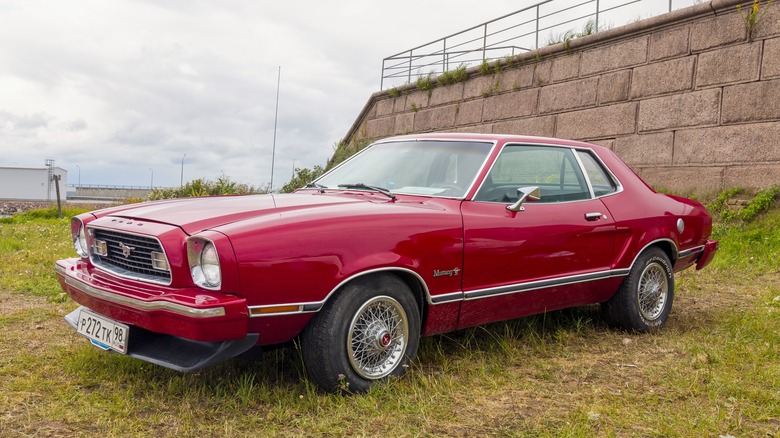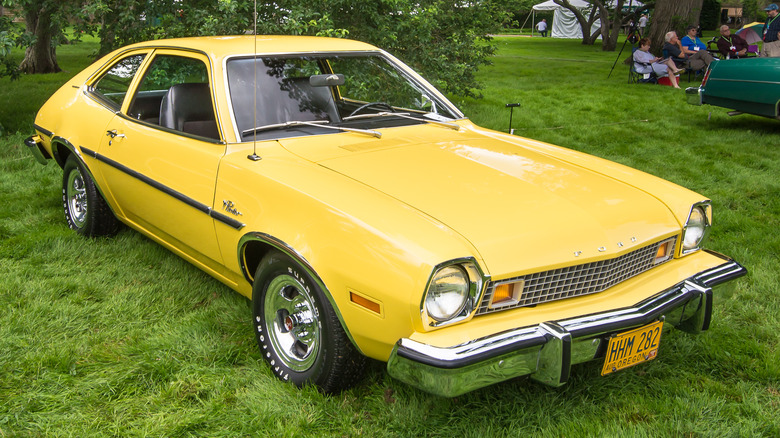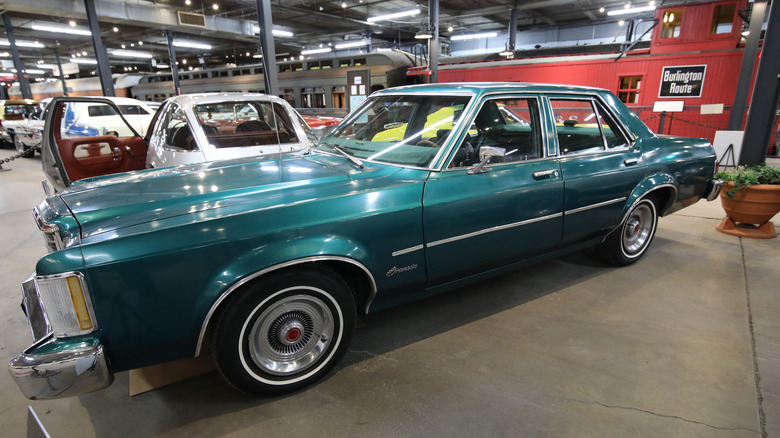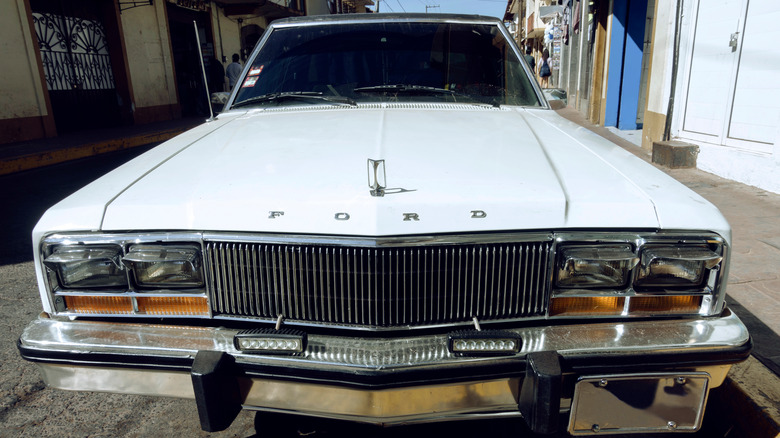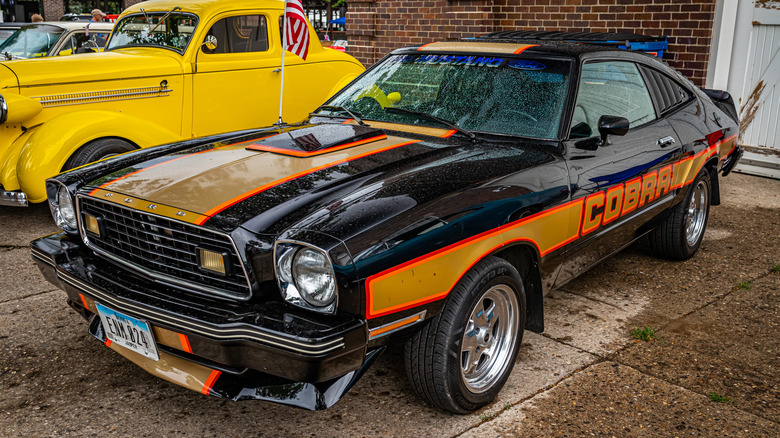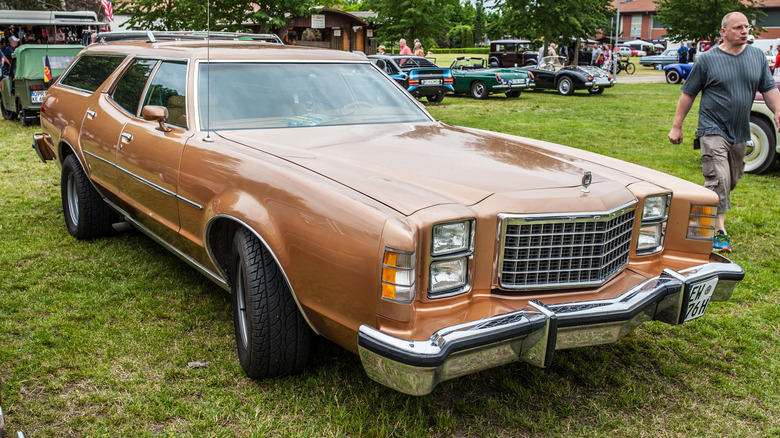5 Of The Worst Cars Ford Made Because Of The 1973 Oil Crisis
In the mid to late 1960s, Ford was one of the most serious players in the U.S. auto market, cornering nearly 30 percent in 1966. Quite a bit of Ford's success at the time can be attributed to some major hits earlier in the decade, including the Ford Mustang in 1964 — which sold over two million units by 1969 — and more practical options like the full-size Ford Galaxie and compact Ford Falcon. The story was the same across the board, as the Big Three U.S. automakers — Ford, Chrysler, and General Motors — were riding a seemingly never-ending wave of success. The American horsepower wars hit its peak around 1968, as all three manufacturers tried to stuff the most powerful engines that they could create into their most capable chassis, leading to the creation of some of the best muscle cars the world has ever seen. Despite the tremendous period of success, a dark cloud was looming on the horizon as the 1960s gave way to the 1970s.
The initial blow for U.S. automakers came in 1970, with the introduction of the Clean Air Act, which significantly handicapped big V8 engines with emissions control measures. Virtually overnight, some of the most potent power plants in history were either discontinued or diluted to the shadows of their previous glory. The real nail in the coffin came in 1973, when OPEC oil suppliers imposed an oil embargo on the United States, essentially tripling the price of oil. U.S. automakers were forced to respond by adapting their existing model lineup or creating new, efficiency-conscious models at the risk of dwindling sales. 1973 marked the start of a 'malaise era' for U.S. automakers that spanned a decade, and Ford created some serious flops as a result.
Ford Pinto
The Ford Pinto has amassed one of the most loyal groups of haters that the automotive industry has ever seen, and there's good reason for that. Outside of the Pinto's obvious shortcomings in the styling department, it truly was a deathtrap on wheels. The Pinto preempted the economy-focused shift in American car manufacturing as a result of the 1973 oil crisis. It was actually the threat of a foreign compact takeover that made then VP of Ford's North American operations Lee Iacocca advocate for a low-cost, low-weight subcompact car to go into production in the early 1970s.
The Pinto's development was a rushed product from the start, with potential safety concerns and problem resolutions being skipped in the name of deadlines and productivity goals. As a result, it ended up as a cobbled-together mess of multiple different cars in the Ford catalog, with more fuel-efficient engines borrowed from European Ford models. When the Pinto was released into the world in 1971, the reviews were average at best. Car and Driver called the Pinto a "low-dollar transit capsule," and other publications complained that it was full of structural deficiencies and had overall shoddy construction.
The Pinto's most severe shortcoming wasn't discovered until there were a lot of them on the road. In 1977, an article entitled "Pinto Madness" appeared in Mother Jones magazine highlighting how dangerous Pintos were to drive, with the main point being that they were prone to exploding if hit from behind. It turned out to be largely true, as the rear-mounted fuel tank was often punctured in rear-end collisions due to the model's poor design. The defect cost a number of Pinto drivers their lives and Ford millions of dollars in settlement fees, tarnishing the already mediocre Pinto with a legacy of disdain.
Ford Granada
The Ford Granada is perhaps the best model out of Detroit to epitomize the fall from grace that American cars had after the 1973 oil crisis. Curbside Classics even went as far as crowning the 1975 Granada as "The Most Malaise Car Ever" in a 2017 retrospective. I tend to agree. The Granada has all of the trademarks of the era rolled up into one package, including a wimpy six-cylinder engine, boxy, unoriginal styling, and little regard for any kind of performance. The advertising campaign at the time didn't even try to hide the fact that the Granada was a half-baked attempt at creating a German saloon for the masses — with the most egregious example being a print ad asking, "Can you tell its looks from a $20,000 Mercedes-Benz?" While looks are one thing, underlying substance is another, and certainly something that the Granada lacked. It lacked the looks too, actually.
The Granada — and sister car Mercury Monarch — were originally created to replace the Ford Maverick and Mercury Comet respectively, but after the 1973 fuel crisis, making the two smaller compacts made more sense. Along the same train of thought, Ford figured that smaller, more fuel-efficient engines would be up to the task of propelling the new models, which seems logical on the surface. That is, until you realize that the base 3.2-liter inline-six cylinder was only capable of 70 horsepower. To put that in perspective, a 1975 Volkswagen Rabbit with an engine half the size made the same amount of power and got it to 60 mph a full 10 seconds faster than the Granada. The Granada was a sheep in wolf's clothing but sold well thanks to the style-over-substance mentality of America in the 70s.
Ford Fairmont
While the Granada was Ford's first half-hearted attempt at European-izing their lineup, it was only the precursor to something more substantial. Just three years after the introduction of the Ford Granada, Ford rolled out the Ford Fairmont, which was built on an entirely new platform. The Fox platform, as it would later be known, was developed to create a new foundation for small cars that utilized more modern technology compared to the outdated chassis of the 1960s. The Fairmont was the first model to use the architecture, which would eventually underpin countless other Ford models all the way through the mid-1990s.
The ultimate goal of the Ford Fairmont was to create a light, simple, and practical car that could get you from A to B consistently. That's it. Everything about it was stripped back to basics, from its no-frills dashboard to its brick-like styling. It was a genuine effort by Ford to disconnect from tacky posturing and provide something with a "less is more" attitude.
To this day, my grandmother has a 1980 Fairmont sitting in her attached garage. A year after I got my driver's license, I backed onto (not into) a parking pole, not yet registering the full importance of side-view mirrors, sending my car to the shop. A stern conversation with my father about the incident ended in him getting my grandmother to agree to lend me her hardly driven Fairmont for the few days that my car was being worked on. Having stepped out of a 1993 Jeep XJ, the Fairmont immediately became the best-handling car that I had ever driven. While the Fairmont wasn't Ford's worst effort in the late 1970s, it was still light years worse than even the rust bucket 1992 Civic that I followed up my XJ with.
Ford Mustang II
The Ford Mustang II is a very polarizing car, mainly due to the fact that the first generation Mustang was an impossible act to follow and that it was a product of its time. Regardless of the fuel crisis, the Mustang was moving in a very different direction by the beginning of the 1970s. Ford was listening to the constructive criticism of the market, complaining that the Mustang was getting bloated by the end of its first generation. Ford, and Mustang progenitor Lee Iacocca in particular, wanted to strip the Mustang back for its second generation.
While that is all well and good if power stayed the same while weight decreased, that wasn't in the cards. When the Mustang II was released in 1973, it was only offered with either a four or six-cylinder engine, much to the dismay of pony enthusiasts looking for a healthy V8. To hurt the Mustang's case even more, it was built on the same chassis as the subcompact Pinto chassis, removing that much more muscle from the Mustang's legacy. Somewhat surprisingly, the second-generation Mustang wasn't met with scathing reviews or public outcry, but with buyers showing up at dealerships. The 1974 Mustang sold as many units as the first generation sold at the peak of its popularity in 1967. It was the car that the American people needed at the time, and Lee Iacocca predicted the market perfectly yet again.
The second-generation Mustang gets its bad reputation from comparison. As a model sandwiched between two of the Mustang's most popular generations, the Mustang II was an embarrassment, but so was every American car at the time. While it is true that the Mustang II is an awful sport scar and the nameplate's weakest model, it isn't truly terrible.
Ford LTD II
The Ford LTD initially hit the market in 1965 as a luxed-up brother to the Galaxie full-size lineup. The entire point of the LTD was to provide a luxury experience to those who couldn't afford a Lincoln or Cadillac. As with most other Ford models peddling "luxury" at the time, all of the additions that made the LTD special were surface level, mostly consisting of ridiculous nylon upholstery and fake wood trim. While the LTD sold well throughout the remainder of the 1960s, the 1970s brought big changes for the LTD and all of Ford's full-size models in general.
As a result of the 1973 fuel crisis, stricter emissions requirements, and a changing consumer climate, American cars were getting smaller by the mid-to-late 1970s. Unlike GM, who invested $20 billion in 1974 to rapidly downsize their cars for the rest of the decade, Ford dragged their feet for as long as they could. When the LTD II arrived in 1977, it was underpinned by the same massive chassis used by the Gran Torino and Elite, making it look like a hulking behemoth of a bygone era compared to its competition. As a result, Ford hurried to redesign it by 1979, resulting in a slightly smaller car that borrowed heavily from the Fairmont.
The immediate reception of the redesigned LTD II was slightly better than the previous version of the model, but in a lesser of two evils kind of way. It was placed behind General Motors' competing models in tests by Car and Driver and Consumer Guide, proving that Ford still had some catching up to do in their efforts to catch up with the times.
